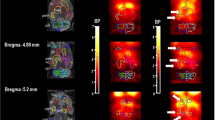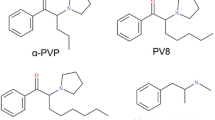Summary
The present study was aimed at investigating the effects of the competitive N-methyl-D-aspartate (NMDA) receptor antagonists D-CPPene (3-(2-carboxypiperazine-4-yl)-propenyl-1-phosphonic acid) and CGS 19755 (cis-4-(phosphonomethyl)piperidine-2-carboxylic acid) on dopamine (DA) transmission and motor activity in mice and rats. As measures of DA release we used mouse brain 3-methoxytyramine (3-MT) levels, an indirect estimate of DA release, and striatal dialysate measures of DA in conscious and freely moving rats by means of microdialysis. To obtain additional information about monoaminergic neurotransmission, brain tissue levels of DA, DOPAC, HVA, 5-HT and 5-HIAA were measured in both mice and rats. The animals were sacrificed at the time when NMDA antagonist-induced locomotor stimulation was maximal. In mice, D-CPPene and CGS 19755 decreased striatal 3-MT levels, whereas, in general, 3-MT levels in the limbic forebrain were not significantly altered. Treatment with CGS 19755 decreased rat striatal dialysate levels of DA but increased 5-HIAA at time points when locomotor activity was increased. D-CPPene and CGS 19755 have been observed to produce psychotic symptoms in man. The present study suggests that these symptoms are not a result of an increase in central dopamine release.
Similar content being viewed by others
References
Angrist B (1987) Pharmacological models of schizophrenia. In: Henn FA, DeLisi LE (eds) Handbook of schizophrenia, vol 2. Neurochemistry and neuropharmacology of schizophrenia. Elsevier, Amsterdam, pp 391–424
Bubser M, Keseberg U, Notz PK, Schmidt WJ (1992) Differential behavioural and biochemical effects of competitive and non-competitive NMDA receptor antagonists in rats. Eur J Pharmacol 229: 75–82
Carlsson A, Lindqvist M (1973) Effect of ethanol on the hydroxylation of tyrosine in rat brain in vivo. J Pharm Pharmacol 25: 437–440
Carlsson A (1988) The current status of the dopamine hypothesis of schizophrenia. Neuropsychopharmacology 1: 179–186 (+ Comments by Meltzer HY)
Carlsson ML (1993) Hypothesis — Are the disparate pharmacological profiles of competitive and un-competitive NMDA antagonists due to different baseline activities of distinct glutamatergic pathways? J Neural Transm [GenSect] 94: 1–10
Commissiong JW (1985) Monoamine metabolites: their relationship and lack of relationship to monoaminergic neuronal activity. Biochem Pharmacol 34: 1127–1131
Crespi F, Garratt JC, Sleigh AJ, Marsden CA (1990) In vivo evidence that 5-hydroxytryptamine (5-HT) neuronal firing and release are not necessarily correlated with 5-HT metabolism. Neuroscience 35: 139–144
Delgado JMR, DeFeudis FV, Roth RH, Ryugo DK, Mitruka BM (1972) Dialytrode for long term intracerebral perfusion in awake monkeys. Arch Int Pharmacodyn 198: 9–21
Engström G, Svensson TH, Waldeck B (1974) Thyroxine and brain catecholamines increased transmitter synthesis and increased receptor sensitivity. Brain Res 72: 471–483
Galloway MP, Bencloucif S, Keegan MJ (1992) Effects of excitatory amino acid manipulation on serotonin facilitation of DA release on vivo microdialysis. Excitatory Amino Acids, Yosemite, California (Abstract, p 19)
Hansson LO, Waters N, Winblad B, Gottfries CG, Carlsson A (1994) Evidence for biochemical heterogeneity in schizophrenia: a multivariate study of monoaminergic indices in human post-mortal tissue. J Neural Transm [GenSect] 98: 217–235
Hiramatsu M, Cho AK, Nabeshima T (1989) Comparison of the behavioral and biochemical effects of the NMDA receptor antagonists, MK-801 and phencyclidine. Eur J Pharmacol 166: 359–366
Javitt DC (1987) Negative schizophrenic symptomatology and the PCP (phencyclidine) model of schizophrenia. Hillside J Clin Psych 9: 12–33
Kehr W (1976) 3-Methoxytyramine as an indicator of impulse-induced dopamine release in rat brain in vivo. Naunyn Schmiedebergs Arch Pharmacol 293: 209–215
Keefe KA, Zigmond MJ, Abercrombie ED (1993) In vivo regulation of extracellular dopamine in the neostriatum: influence of activity and local excitatory amino acids. J Neural Transm [GenSect] 91: 223–240
Kim JS, Kornhuber HH, Schmid-Burgk W, Holzmüller B (1980) Low cerebrospinal fluid glutamate in schizophrenic patients and a new hypothesis on schizophrenia. Neurosci Lett 20: 379–382
Krnjevic K, Lamour Y, Macdonald JF, Nistri A (1978) Intracellular actions of monoamine transmitters. Can J Physiol Pharmacol 56: 896–900
Leviel V, Gobert A, Guibert B (1990) The glutamate-mediated release of dopamine in the rat striatum: further characterization of the dual excitatory-inhibitory function. Neuroscience 39: 305–312
Liljequist S, Ossowska K, Grabowska-Andén, Andén N-E (1991) Effect of the NMDA receptor antagonist, MK-801, on locomotor activity and on the metabolism of dopamine in various brain areas of mice. Eur J Pharmacol 195: 55–61
Lillrank SM, O'Connor WT, Oja SS, Ungerstedt U (1994) Systemic phencyclidine administration is associated with increased dopamine, GABA, and 5-HIAA levels in the dorsolateral striatum of conscious rats: an in vivo microdialysis study. J Neural Transm [GenSect] 95: 145–155
Lodge D, Johnson KM (1990) Noncompetitive excitatory amino acid receptor antagonists. Trends Pharmacol Sci 11: 81–86
Löscher W, Annies R, Hönack D (1991) The N-methyl-D-aspartate antagonist MK-801 induces increases in dopamine and serotonin metabolism in several brain regions of rat. Neurosci Lett 128: 191–194
Löscher W, Annies R, Hönack D (1993) Comparison of competitive and uncompetitive NMDA receptor antagonists with regard to monoaminergic neuronal activity and behavioral effects in rats. Eur J Pharmacol 242: 263–274
Martin GE (1986) Catecholamine release within the striatum of the freely moving rat. Ann NY Acad Sci 473: 151–159
Meldrum BS, Kerwin RW (1987) Glutamate receptors and schizophrenia. J Psychopharmacol 1: 217–221
Miu P, Karoum F, Toffano G, Commissiong JW (1992) Regulatory aspects of nigrostriatal dopaminergic neurons. Exp Brain Res 91: 489–495
Moghaddam B, Gruen RJ (1991) Do endogenous exicatory amino acids influence striatal dopamine release. Brain Res 544: 329–330
Moghaddam B, Bunney BS (1989) Ionic composition of microdialysis perfusing solution alters the pharmacological responsiveness and basal outflow of striatal dopamine. J Neurochem 53: 652–665
Moghaddam B, Gruen RJ, Roth RH, Bunney BS, Adams RN (1990) Effect of L-glutamate on the release of striatal dopamine: in vivo dialysis and electrochemical studies. Brain Res 518: 55–60
Pawlowski L, Mathé JM, Svensson TH (1990) Phencyclidine activates rat A10 dopamine neurons but reduces burst activity and causes regularization of firing. Acta Physiol Scand 139: 529–530
Paxinos G, Watson C (1986) The rat brain in stereotaxic coordinates, 2nd ed. Academic Press, New York
Svensson A, Pileblad E, Carlsson M (1991) A comparison between the non-competitive NMDA antagonist dizocilpine (MK-801) and the competitive NMDA antagonist D-CPPene with regard to dopamine turnover and locomotor-stimulatory properties in mice. J Neural Transm [GenSect] 85: 117–129
Svensson K, Johansson AM, Magnusson T, Carlsson A (1986) (+)-AJ76 and (+)-UH232: central stimulants acting as preferential dopamine autoreceptor antagonists. Naunyn Schmiedebergs Arch Pharmacol 334: 234–245
Troupin AS, Mendius JR, Cheng F, Risinger MW (1986) In: Watkins JC, Collingridge GL (eds) New anticonvulsant drugs. John Libbey, London, pp 191–201
Waters N, Lagerkvist S, Löfberg L, Piercey M, Carlsson A (1993) The dopamine D3 receptor and autoreceptor preferring antagonists (+)-AJ76 and (+)-UH232; a microdialysis study. Eur J Pharmacol 242: 151–163
Westerink BHC, Justice JB (1991) Microdialysis compared with other in vivo release models. In: Robinson TE, Justice JB (eds) Microdialysis in the neurosciences. Elsevier, Amsterdam London New York Tokyo, p 28
Weihmuller FB, O'Dell SJ, Cole BN, Marshall JF (1991) MK-801 attenuates the dopamine-releasing but not the behavioral effects of methamphetamine: an in vivo microdialysis study. Brain Res 549: 230–235
Zetterström T, Sharp T, Marsden CA, Ungerstedt U (1983) In vivo measurement of dopamine and its metabolites by intracerebral dialysis: changes after d-amphetamine. J Neurochem 41: 1769–1773
Author information
Authors and Affiliations
Rights and permissions
About this article
Cite this article
Waters, N., Lundgren, C., Hansson, L.O. et al. Concurrent locomotor stimulation and decrease in dopamine release in rats and mice after treatment with the competitive NMDA receptor antagonists D-CPPene and CGS 19755. J. Neural Transmission 103, 117–129 (1996). https://doi.org/10.1007/BF01292621
Received:
Accepted:
Issue Date:
DOI: https://doi.org/10.1007/BF01292621




